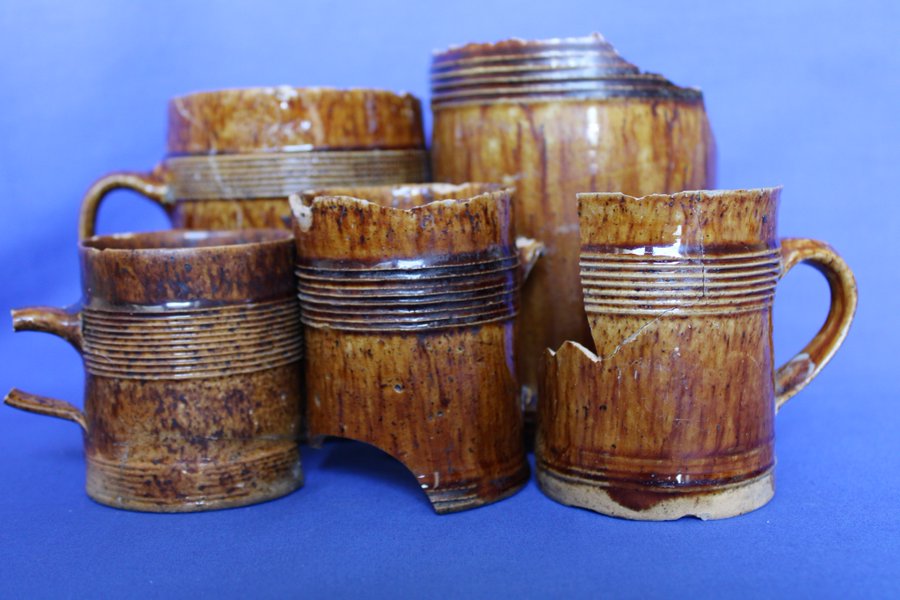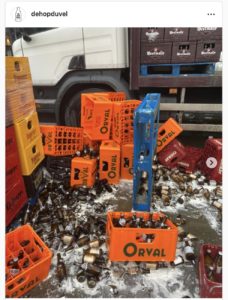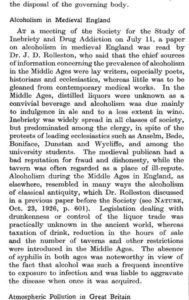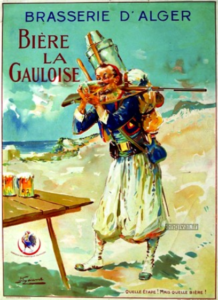 OK, so what’s going on. I am still a bit stunned from the residual effects of da ‘Vid but I also got my taxes done last weekend as opposed to my usual next weekend deadline date with the docts. I have no idea why I didn’t wait for the last minute like usual. To celebrate or maybe just to get me through the filing process, last weekend I finally found a way to get a kick out of a fruity kettle sour. Eat cookies with them. Specifically, the coconut laced Voortman Strawberry Turnover known throughout Ontario when chased by a Left Field Strawberry Rhubarb Sour. YOWSA!!! Any bar that doesn’t stock up the $3.25 grocery store find and then resell to aspiring drunks for $6 is NUTSO!!! Candy. Baby. Boom.
OK, so what’s going on. I am still a bit stunned from the residual effects of da ‘Vid but I also got my taxes done last weekend as opposed to my usual next weekend deadline date with the docts. I have no idea why I didn’t wait for the last minute like usual. To celebrate or maybe just to get me through the filing process, last weekend I finally found a way to get a kick out of a fruity kettle sour. Eat cookies with them. Specifically, the coconut laced Voortman Strawberry Turnover known throughout Ontario when chased by a Left Field Strawberry Rhubarb Sour. YOWSA!!! Any bar that doesn’t stock up the $3.25 grocery store find and then resell to aspiring drunks for $6 is NUTSO!!! Candy. Baby. Boom.
9:20 AM Update: David Jesudason has published another teaser for his much anticipated book on Desi Pubs called Desi Pubs (to be published BTW in a few weeks on May 17th) this time in the newsletter Brown History:
“I must admit I’m a bit nervous. There will be a few difficult customers, no doubt, but I think I shall be able to manage.” Few remember the modest man who spoke these words about the Leicester business he was about to take over in 1962, but unknowingly he was to become a British-Indian trailblazer who paved the way for many others. His name was Soham Singh and he was being interviewed by local newspapers because he was deemed Britain’s first “coloured innkeeper” after he started running the Durham Ox pub with his wife Janet (described as an attractive 28-year-old English woman, “whom he married in a Sikh Temple five years earlier”).
I have to admit I find these writings of his torturous to the point of being tortious – but never, of course, tortuous – as I have no access to a good Desi Pub but expect I would love having access to a good Desi Pub.
First up, Pellicle published an interesting article on a not very hot topic – the effect of a closure of local brewery:
I grew up in weather-beaten pubs like these, as did my father and his father before him. If you were local, you would say we were hefted to the land, such is our family’s connection to this obscure north-western part of this obscure north-western English county. Until recently, when it was closed by parent company Carlsberg Marston’s, there was a brewery hefted to this land too. A brewery called Jennings.
Semi-spoiler: “…the disastrous rebrand…”
And, Stan is back from the Antipodes and reported on the New Zealand hop scene in his latest edition of Hop Queries – including on one matter I might not have noticed myself:
Equally surprising was to see that most often the hops are strung to 4.8 meters (less than 16 feet) on 5.4 meter trellises, so not as high as in other hop growing regions. Farmers in the American Northwest grow hops on 18-foot-high trellises, while in Europe seven meters is standard outside of the Tettnang region of Germany. In Tettnang, older varieties are strung to eight meters and newer ones to seven. I heard several suggestions about why New Zealand farms have lower trellises, and will report back once I sort out if there is a definitive answer.
The Beer Nut undertook a bit of market research by studying the JD Wetherspoon Spring Fest 2023 so you don’t have to and seems to have appreciated the experience as…
then, instantly, all the festival beers disappeared from the Dublin branches a day before the event was due to end. Maybe they bought exactly the right amount of beer, though I would be surprised. Overall there was enough decent stuff in the above to keep me happy, and no outright disasters. I still miss the token 7-8%er that used to lurk at the bottom of every programme. Bring that back.
And, like The Beer Nt, as we look forward to the Coronation next weekend, when 17 million extra pints will be downed, this story in the Scotsman about the role one pub played in the protection of the Stone of DESTINY!!!
According to pub legend, the real Stone of Destiny resides in the historic bar, The Arlington which has been operating since 1860, as this was where the students who stole it hid it. The story goes that the Stone of Destiny that was returned was a replica that had been fashioned by the students. The Arlington bar, which is located on Woodlands Road, displays the ‘real’ Stone of Destiny prominently in a glass case on the bar.
 Speaking of Scotland, this tweet was maybe interesting. Apparently, at least on the books, BrewDog is losing money… well, lost it in 2021 when, you know, everyone was losing money. They ended up with almost £14m less in year end cash after taking in almost £20m in share sales… ie non-earned income. All on an net operating cash flow of £12.5m. But they spent £21m on property and equipment which is usually good. But then lent £20m to subsidiaries… which is… perhaps speculative. Maybe.
Speaking of Scotland, this tweet was maybe interesting. Apparently, at least on the books, BrewDog is losing money… well, lost it in 2021 when, you know, everyone was losing money. They ended up with almost £14m less in year end cash after taking in almost £20m in share sales… ie non-earned income. All on an net operating cash flow of £12.5m. But they spent £21m on property and equipment which is usually good. But then lent £20m to subsidiaries… which is… perhaps speculative. Maybe.
Speaking of 2021, stats for alcohol use on the isle of Jersey were released and the societal effects are a bit staggering even if drinking is down 25% since 2000:
…in 2021, there were 725 hospital admissions specifically related to alcohol per 100,000 population, similar to the English rate of 626 per 100,000. Two thirds of alcohol-specific hospital admissions were men, the report showed. The report said alcohol played a role in almost one in six of all crimes recorded in Jersey in 2022, with 32% of assaults and serious assaults, 11% of domestic assaults and 23% of offences in the St Helier night-time economy.
I have a pal named Dave who is the CBC afternoon radio guy in Yukon. This week he had an interesting interview with sake importer Patrick Ellis which helpfully unpacks a lot of the basics of the drink.
Did you know that Brazilians over a certain age can now buy decade specific beer brands? I read about it on the internet, myself:
Beck’s 70+ offers a chance to start “a dialogue with the pro-aging culture movement, which understands that age does not limit people’s desires and aspirations,” he says. Well, that’s probably aiming a bit too high. Still, it’s a smart nod to an oft-marginalized audience, a welcome respite from the think/act/feel/dress/drink young ethos that’s getting so darn old already.
Jeff speculated on the implications of the “not at all news” that craft beer has become incredibly boring. We know that because appartently the Brewers Association says sales are flat… which really means they really are BZZZZZzzzzzmmmm….(….’fssst…)…zzzblubt……flpt… KABOOM! Regardless, Jeff suggests a few things including:
With so much excess capacity in the industry, contract brewing is an attractive way to launch a brand cheaply. A slightly different model gaining traction is the alternating proprietorship—basically, a shared brewery. The two or more separate companies schedule time on one brewhouse and then have devoted tanks on the cold side. I’d never heard of this until Ruse launched their brand that way at Culmination. Some time later, Pono did the same with Zoiglhaus. Both Ruse and Pono had their eyes set on using these arrangements to bootstrap up to their own breweries and taprooms, and both have since done so.
I have known contract brewing where there is an expansion. Where there are hopes and dreams. And, in a way maybe, brewing co-operatives where the best stout known to humanity was made. Who knows? Could be.
What else is going on? Lisa‘s off being a weirdo again this time sharing her very own 2023-esque and rather dramatic Guinness story:
Glances were exchanged all around the bar – after all, many of the tourists were here specifically to try other local beers – but she wasn’t done yet. ‘Are you SERIOUSLY SUGGESTING I cannot get a Guinness – IRELAND’S NATIONAL DRINK – at this so-called Irish pub?’ There was a pause, as she looked around for support, and she continued, at a further-increased volume, ‘do any of you here find this AT ALL ACCEPTIBLE?’ To the credit of absolutely everyone in the pub, not a single person responded directly, though there was a light chuckle toward the back of the room. After another dramatic pause, she tried once more to garner some kind of support – once again, upping the decibels: ‘I cannot BELIEVE that a business like this can exist, in this day and age, calling itself an IRISH PUB without Guinness.’ And with that, she turned on her heel and flounced out of the pub.
You know, Lisa really needs to get me interviewed on that podcast. I nkow it’s a group decision but I really could answer questions like “seriously, Al, what the hell?” and “when does the song ‘Time the Avenger’ start meaning different things?” and stuff like that.
What else… Miller cans crushed in Europe? Don’t care. Heineken not caring about poor widdle cwaft beer’s feelings? Who cares? But, hey, what’s that? Could that be true?  The white lab-coated nerds at the Brno University of Technology in the Czech Republic are at it again… with ROBOTS FILLED WITH YEAST:
The white lab-coated nerds at the Brno University of Technology in the Czech Republic are at it again… with ROBOTS FILLED WITH YEAST:
Millimetre-sized robots made of iron oxide and packed with yeast speed up fermentation of beer by swimming around in the fermenting container and can be removed with a magnet, eliminating the need for filtering out yeast
That’s extra nutso. Here’s a 2020 paper published by the Europeans Chemistry Society explaining the process. Egg. Heads.
That’s enough from me. Back to social media scrolling and fretting over the risk of frost. BTW… fine. Mastodon not taking off like you expected? Do what you like. But here’s your Masto-newb cheat sheet. Because… because… things work best when folk get tucked in… Substack notes ain’t anyone’s saviour. I’m getting t-shirt made that says that. You wait… I will…
Stan Hieronymus | The Man!
Boak & Bailey | The B² experience
Katie Mather | Shiny Biscuit and Corto
David Jesudason | “Desi Pubs” (2023) author
Ron Pattinson | The RonAlongAThon Himself
Al Reece AKA Velky Al | Fuggled
Jennifer Jordan | US hops historian
Alan McLeod | A Good Beer Blog (… me…)
Andreas Krennmair | Vienna beer and lager historian
Beer Ladies Podcast | Lisa Grimm and colleagues
Jay Brooks | Brookston Beer Bulletin
Joe Stange | Belgian beer expert, beer magazine editor
Cider Bar | Barry makes Kertelreiter cider
Laura Hadland | CAMRA historian and beer writer
Brian Alberts | US beer historian
Jon Abernathy | The Beer Site
Maureen Ogle | US Beer Historian
Lars Garshol | Norwegian Beer Historian and Kveik Hunter
James Beeson | Beeson on Beer
Carla Jean | MAINER!!!
Thandi Guilherme | Beer Ladies Podcast Co-host
Lisa Grimm | Beer Ladies Podcast Co-host
Rob Talksbeer | Podcaster and Youtuber
Anthony Gladman | UK Drinks Writer
Jeff Alworth | Manna Of Beervana
Northwest Beer Guide | Fairly self explanatory… but not NW Latvia…
Evan Rail | Prague based GBH editor, freelance writer, NYT etc.
Todd Alström | 50% of the Alströms
Jacob Berg | Beer talking librarian
Anyone else? And, yes, we also check the blogs, podcasts and newsletters to stay on top of things – including more weekly recommendations from Boak and Bailey every Saturday and now definitely from Stan at his spot on those Mondays! Get your emailed issue of Episodes of my Pub Life by David Jesudason every Friday. Once a month, Will Hawkes issues his London Beer City newsletter and do sign up for Katie’s wonderful newsletter, The Gulp, too. Ben’s Beer and Badword is back! And check out the Atlantic Canada Beer Blog‘s weekly roundup. There is new reading at The Glass. Any more? Yes! Check to see the highly recommended Beer Ladies Podcast. And the long standing Beervana podcast . There is the Boys Are From Märzen podcast too and check out the travel vids at Ontario’s own A Quick Beer. There is more from DaftAboutCraft‘s podcast, too. Ben has revived his podcast, Beer and Badword. Still gearing up, the recently revived All About Beer has introduced a podcast, too even if it’s a bit trade… and by “a bit” I think mean not really just a bit. There’s also The Perfect Pour. Plus follow the venerable Full Pint podcast. And the Craft Beer Channel this week on Youtube. And remember BeerEdge, too, and The Moon Under Water… if you have $10 a month for this sort of thing… I don’t. Pete Brown’s costs a fifth of that. There was also the Beer O’clock Show but that was gone after a ten year run but returned renewed and here is the link!*
*And finally the list of the departed newsletters and podcasts or those in purgatory. Looks like both Brewsround and Cabin Fever died in 2020, . We appreciate that the OCBG Podcast is on a very quiet schedule these days – but it’s been there now and again. The Fizz died in 2019. Plus Fermentation Radio with Emma Inch seems done and the AfroBeerChick podcast is gone as well! The Fingers Podcast packed it in citing, umm, lack of success… as might have been anticipated, honestly. Did they suffer a common fate? Who knows?













 The autumn leaves are a ways off falling but the time is coming fast. We have had nothing but great grass growing weather in these parts so more with the mowing than action with the rake so far. And as we say goodbye to saying goodbye
The autumn leaves are a ways off falling but the time is coming fast. We have had nothing but great grass growing weather in these parts so more with the mowing than action with the rake so far. And as we say goodbye to saying goodbye I was thinking of what to post as an image this week, given this time of mourning for HM**** QEII. And here it is – the declaration of the passing and proclamation of the new sovereignty… in
I was thinking of what to post as an image this week, given this time of mourning for HM**** QEII. And here it is – the declaration of the passing and proclamation of the new sovereignty… in  Moving away from that news and a little bit, what has gone on out there this week? Well,
Moving away from that news and a little bit, what has gone on out there this week? Well, 
